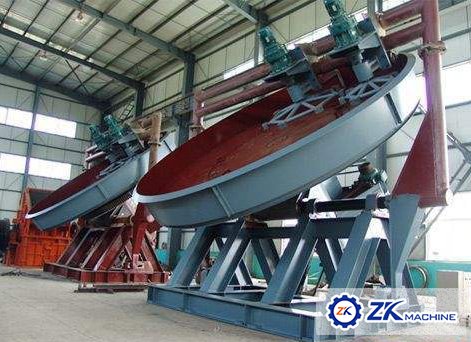Operational Precautions For Ceramsite Sand Granulator
Date:2019-09-16 18:29:59
Author:admin
Views:
214
The ceramsite is obtained by pulverizing and homogenizing shale or clay with swelling property, adding an activator and water to form a spherical shape, and swelling at a high temperature with a ceramsite rotary kiln, and sieving, drying and granulating. The process of ceramsite sand granulator into a ball is very complicated. The formation of the raw material ball generally passes through two stages of the formation of the cue ball and the period of growth and compaction. It’s difficult to reach the various indicators required by the ceramsite.
ZK Corp has rich experience and a large amount of experimental data in ceramsite sand granulation process and ceramsite equipment manufacturing. It has achieved good results in practical application and won high praise from users. Here, ZK Corp engineer explains the following points that should be paid attention to when operating the ceramsite sand granulator for the majority of users:
1. Paving the bottom layer material of the granulator
Before the granulator is properly formed into a ball, the bottom layer must be laid to avoid the wear of the granulator and the normal granulation.
Operation method of paving the bottom layer: After the preparation work is finished, start the granulator, wait for the granulator to operate normally, then open the water adding valve, stop the watering after the bottom of the plate is sprayed, and evenly feed (mixture) with the disc feeder to make the material evenly spread. At the end of the plate, a thin layer is formed, and then water is gradually added to form a hard layer. The thickness of the bottom layer is controlled by the distance between the blade and the bottom of the disk, which is generally 3 mm.
As the blade wears, the thickness of the underlayer increases. The material layer is too thick, easy to fall, affecting the quality of the raw material ball, thus reducing the inner volume of the disk and reducing the yield. Therefore, the bottom layer should not be too thick, usually when it is increased to 10 mm, the scraper must be replaced. If the mixture is too thick, the plasticity is weakened, and it is difficult paving the bottom layer. Therefore, the mixture of the bottom layer of the disc is required to have a finer fineness, and generally should be controlled to 4,900 holes/cm 2 and the remaining amount of the screen is about 20%.
2. Control the amount of water added to the granulator
When the bottom layer of the granulator is formed, the amount of material to be fed and the amount of water added are gradually increased. At the same time, it is necessary to break the relatively soft large balls and blocks formed in the disc in time to make the ball become normal. At this point, the feed can be continuously added with water, and the qualified raw material balls are continuously discharged, showing a balanced state. The movement track of the material in the tray is clear, and the ratio of the material to the ball is about 1:2, which is normal operation.
A common problem in operation is that the ball is too large or too small. The reason for the large material ball is that the material is wet, the material is fine, the amount of water is large, the inclination angle of the granulator is small, and the edge plate is high. The solution is usually to reduce the amount of water added or water for a period of time, increase the amount of material to be cut, and appropriately increase the inclination of the granulator. As a temporary measure, some ceramic sand can be sprinkled into the granulator (the number of cue balls can be increased and the particle size can be reduced). The reason for the small ball is opposite to the above. The solution is usually to increase the amount of water, move the watering position to the ball and powder area, reduce the amount of material, and adjust the angle of the granulator appropriately.
3. Control the amount of clay in the granulator
If the amount of clay is too large, the ball will be small, the ball will not be round, and the amount of clay incorporated will be too small, making it difficult to form a ball. In the above situation, the ingredients should be notified in time to adjust the amount of clay. When it is found that the material is coarse or fine, the ash section shall be notified to adjust the ratio of coarse and fine ash. Under normal circumstances, the material is coarse, and the granulator has a smaller inclination; the material is fine, and the granulator has a larger inclination. Dry the material, increase the amount of water, reduce the amount of material; reduce the amount of water, reduce the amount of water, and increase the amount of material.
4. Check granulator scraper
The operator should always break the large ball or block that appears in the pan with iron tweezers, check the wear of the scraper, and replace it in time.
5. Granulator parking sequence
When there is a failure in the production process and needs to stop, the feeding and watering should be stopped first, the ball of the granulator should be removed by one third, and then the disk should be stopped to reduce the secondary starting load of the ball plate, and finally stop the belt conveyor.

